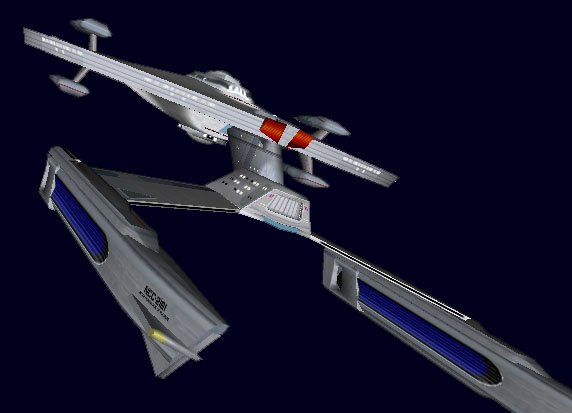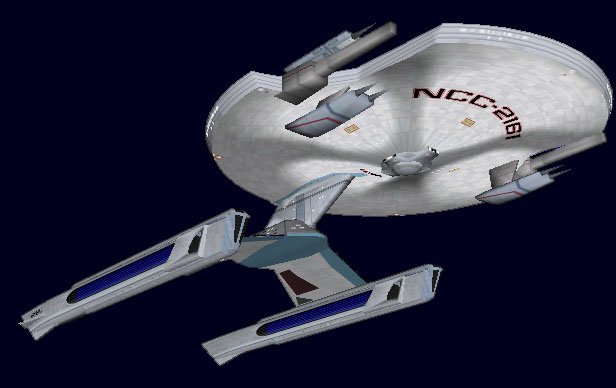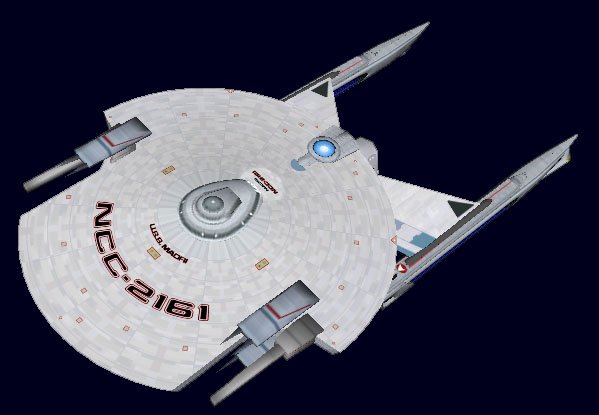
 Clyde Fleet Shipyards
USS Maori NCC-2161
Trista-class long range scout
Clyde Fleet Shipyards
USS Maori NCC-2161
Trista-class long range scout
Owner/Operator: United Federation of Planets/Starfleet.
Type: Long-range scout vessel
Availability: Limited. In service from 2293
Production Run: 20 ships, 2293-2296
Statistics
Length: 261.1m
Beam: 141.7m
Height: 60.0m
Armament
Phasers: Six (6) banks of paired Type-VII emitters giving 720 degree arc;
Torpedoes: N/A.
 History
History
Named for an ancient Saurian tribe of warriors and hunters, this class of vessel is the currently the ultimate development of the “large scout” concept first embodied by the Hermes class in the 2250s. With a design lineage that includes the Monoceros-class, the Hermes (refit I)-class, the Kearsage-class “new scout cruiser” variant, and the Kestrel-class scout, this vessel combines and adds onto all these design elements for a ship with superior capabilities for the 2290s and beyond.
Taking the basic Hermes (refit I)-class layout with its full-sized saucer for plenty of SigInt and Cryptography laboratories and massive computer facilities, the Trista-class adds in the far more fuel-efficient twin nacelle warp engine arrangement of the Kearsage. This allows a large speed increase and far greater range for less wear and tear on parts, reducing maintenance needs – always desirable in a vessel purpose-built for extended duration missions in uncharted territory, far from the nearest starbase. Further added to this is a sensor suite developed from the Kestrel-class’ massive underslung sensor array. Arranged more compactly and fitted directly into the hull to increase warp-field efficiency, two OC10589W very long range passive sensor arrays are mounted on the forward saucer cut-out quarters, Port and Starboard. Their large surface area and the power of a destroyer-class warp reactor allows them an unparalleled sensitivity for the detection of both subspace & realspace communications signals, and warp-field detection. Four OC10273T very long range active sensor arrays are mounted above and below the forward saucer cut-out quarters, Port and Starboard. Usable in both interstellar and orbital ranges, these sensors are at the bleeding edge of Federation scientific and technological excellence.
To create more space for crew facilities such as quarters, recreation, laboratories, and computer processing power, the standard internal shuttlebay of the previous classes is dispensed with and a dedicated shuttlebay is mounted at the base of the dorsal neck, which also incorporates the Trista's multiple probe launchers.
 A standard saucer complement of 6 banks of twinned Type VII phaser emitters provides a more than adequate defence, and a photon torpedo armament was omitted, as is standard practice for large scout classes.
A standard saucer complement of 6 banks of twinned Type VII phaser emitters provides a more than adequate defence, and a photon torpedo armament was omitted, as is standard practice for large scout classes.
As a scout class expected to transition long distances of interstellar void, the physical structure of these ships are specially reinforced for extended duration at high warp speeds. Their structural integrity field is rated to heavy cruiser levels, and their emergency speed of warp 10.63 (Cochrane scale, 1200c) can be maintained for 48 hours. Their flank speed of warp 10 (Cochrane scale, 1000c) can be maintained for ten days, and their max safe (indefinite) cruise speed is warp 8.5 (Cochrane scale, 614c). Compare this to the Constitution class heavy cruisers, whose equivalent max safe speeds are warp 10, warp 9.5, and warp 8 respectively for Emergency, Flank, and Max Cruise.
This class of 20 vessels is named after various ancient tribal units from worlds across the Federation renowned for their tracking and navigational abilities.
Operations:
The Trista class are operated in conjunction with Starfleet Intelligence and under a veil of security with secrecy matched by few other missions such as the Phantom class scouts. As policy, Starfleet does not discuss the locations or missions of the Trista class scouts. Starfleet runs these missions under a strict policy of need-to-know and those in the loop are kept to a minimum. It is believed that the intelligence-gathering missions are run with just three ships: one Trista class, one Phantom class and one escorting Akula class destroyer or Jupp class escort destroyer left nearby, but not with the exact position of either of the other two assets.
U.S.S. Gaul, NCC-2167
The Gaul is currently assigned to the Lyran Star Empire and Lyran Democratic Republic, passing between the Mirak and Lyran border unseen. This vessel is on a long-term assignment sent from Station Eris Five. She is assigned to monitor the communications (CommInt) of both the Mirak and Lyrans, pro-active precaution against another repeat of the repeated Mirak-Lyran wars. As part of this, the Gaul monitors the transmissions beteen the defensive systems of both sides (SigInt) and the sensor scans and warp signatures of their ships and probes (Elint).
The U.S.S. Gaul, NCC 2167, had been on station at the Mirak/Lyran border region for the past nine months, monitoring the electronic transmissions and communications from both sides. Every six months the crew was rotated in order to keep them all fresh; the isolation felt in this mission type soon took its toll. The Akula class U.S.S. Cowpens would rendezvous with the ship and transfers would start. This way the ship could stay on station and maintain secrecy on her location.
Fleet movements on both sides of the border were closely monitored and examined by the Gaul. Before the recently-announced trade agreement, the Gaul had monitored freighters travelling between Klingon space and the Mirak. No warships had been seen at that time. Cloaked ships were a possibility, proving it would be difficult after the event.
These Klingon vessels were shadowed afar from Okinawa and Phobos class starships throughout the Demilitarised Zone. Gaul detected possible cloaked starship signatures but the presence of a Trista class scout could not be divulged. The deployments of this class were amongst the closest guarded secrets of Starfleet. This was an ace card that could not be wasted.
The Gaul acted solo, with one defensive wingman aware of her position in case of needing assistance-in this case the Cowpens. Her location was kept secret so as not to compromise her mission. In reality she was 'very close' to the borders in order to soak up as much transmissions and fleet movements as possible. The starship was shrouded in secrecy as far as her capabilities were concerned. Whilst Starfleet was an agency that espoused non-interference in the affairs of others, this did not extend as far as studying the activities of her neighbours, trying to understand what they were up to and why.
For Captain Asvald Thorirsson the assignment had an element of 'Big Brother' to it, overseeing the mission of the U.S.S. Fearless from afar. Whilst the Excelsior class starship met with the Lyran leadership, the Gaul had used her superior sensor suite to monitor the transmissions of the Lyran military command and diplomatic channels. The Gaul was not able to decipher much of the communications- especially the hyper encrypted channels- the amount of signals and their concentrations gave much away about the intentions of the Lyrans, and the disposition of their fleet.
Mountain Watcher clan is amongst those of interest to Starfleet Command.
Captain Asvald Thorirsson, human male from Iceland.
Commander Justyna , human female from Poland.
U.S.S. Pict, NCC
This Trista class scout is currently patrolling along the Interstellar Concordium border. In 2307 she was out there with the Phantom class Lich when the ISC deployed their subspace mirror, shielding their nation from prying eyes.
Captain , human female from Arabia.
Commander , Andorian female.
Credits:
Class creator and history: Scottish Andy
Kitbasher: Scottish Andy
Minor Retexturing: Scottish Andy
Scale: Scottish Andy
Hardpoints & Damage Points: untouched
Models & Textures used: Moonraker’s New Haven class, Atrahasis’ Belknap class, Lord Schtupp’s shuttlebay (for Atrahasis & Firesoul’s Salazar-class), Marauth's retextures of Wicked Zombies original F-CA saucer textures for USS Sicilia model from Rogue Shipyards.









 History
History A standard saucer complement of 6 banks of twinned Type VII phaser emitters provides a more than adequate defence, and a photon torpedo armament was omitted, as is standard practice for large scout classes.
A standard saucer complement of 6 banks of twinned Type VII phaser emitters provides a more than adequate defence, and a photon torpedo armament was omitted, as is standard practice for large scout classes.




